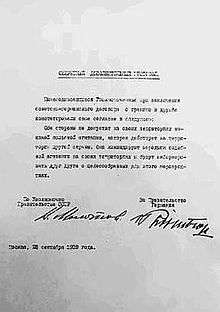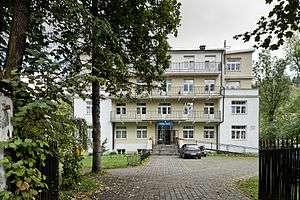Gestapo–NKVD Conferences
|
Location of the 3rd Gestapo–NKVD conference inside the German torture house in the Polish mountains, the 'Palace' villa in Zakopane today | |
| Time |
|
|---|---|
| Duration | 1939–1940 |
| Type | Nazi-Soviet bilateral planning for the persecution of Polish nationals |
| Theme | Secret police talks |
| Cause | 1939 Invasion of Poland |
The Gestapo–NKVD conferences were a series of secret police meetings organized in late 1939 and early 1940 by the German and Soviet officials following their joint invasion of Poland in accordance with the Nazi-Soviet alliance.[1][2] The purpose of the meetings was to enable the German and Soviet security forces including Gestapo and NKVD respectively, to share information regarding their parallel terror operations in occupied Poland. In spite of their differences on other issues, both Heinrich Himmler and Lavrentiy Beria had common goals as far as the fate of Poland was concerned.[3] The known conferences were devoted to coordinating plans for joint destruction of Polish nationhood as well as discussing ways of dealing with the Polish resistance during World War II.[4][5]
Out of four conferences,[4] the third took place in the famous spa of Zakopane in the Tatra Mountains of southern Poland; it is the most remembered, as the Zakopane Conference. From the Soviet side, several higher officers of the NKVD secret police participated in the meetings, while the German hosts provided a group of experts from the Gestapo.[1]
Prelude
After the signing of the Molotov–Ribbentrop Pact on 23 August 1939, Germany invaded Poland on 1 September[6][7] and the Soviet Union invaded Poland on 17 September[6][8] resulting in the occupation of Poland by the Soviet Union and Nazi Germany.
First Conference

The first Gestapo–NKVD meeting took place reportedly on 27 September 1939 in Brześć nad Bugiem, while some units of the Polish Army were still fighting (see: Invasion of Poland) resulting in mass internment of soldiers and their extrajudicial shootings across the Curzon Line. Both Gestapo and NKVD expected the emergence of Polish resistance and discussed ways of dealing with the clandestine activities of the Poles. In the immediate aftermath of the meeting, the Soviet NKVD began the collection of data leading to the Katyn massacre committed in the spring of 1940.[5][2]
Second Conference
This meeting took place some time at the end of November 1939, probably in Przemyśl,[2] divided into German and Soviet zones of occupation between September 1939 and June 1941. Apart from talks of fighting Polish resistance, the Soviets and the Germans discussed ways of exchanging Polish POWs. Also, first discussions about the occupation of Poland were started. Some historians claim this meeting took place in Lwów.[1][3] It is also claimed a meeting was held in December.[5][9]

Third Conference
This one is the best known, and took place in Zakopane,[10] starting on 20 February 1940[5] in the villa "Pan Tadeusz", located at the Droga do Białego street close to the Dolina Białego valley. The German side was represented by Adolf Eichmann and an official by the name of Zimmermann, who later became chief of the Radom District of the General Government territory. The Soviet delegation was headed by Grigoriy Litvinov and — among others — Rita Zimmerman (director of a gold mine in Kolyma) and a man named Eichmans, creator of an efficient way of killing in the back of the head.[2]
According to several sources, one of the results of this conference was the German Ausserordentliche Befriedungsaktion (see: German AB Action operation in Poland),[11] elimination of Krakow intelligentsia Sonderaktion Krakau and the Soviet Katyn massacre[5][12] In his 1991 book Stalin: Breaker of Nations, British historian Robert Conquest stated: "Terminal horror suffered by so many millions of innocent Jewish, Slavic, and other European peoples as a result of this meeting of evil minds is an indelible stain on the history and integrity of Western civilization, with all of its humanitarian pretensions". Also, Professor George Watson of Cambridge University concluded in his "Rehearsal for the Holocaust?" commentary (June 1981) that the fate of the interned Polish officers may have been decided at this conference.[13][14] This is however disputed by other historians, who point out that there is no documentary evidence confirming any cooperation on that issue, that the existing Soviet documentation actually makes such a cooperation improbable and that it is reasonable to say that Germany did not know about the Katyn massacre until the corpses were found.[15]
Fourth Conference
The fourth and last meeting took place in March 1940 in Krakow[16] (according to some historians, it was part of the Zakopane Conference). This event was described by General Tadeusz Bór-Komorowski, commander of Armia Krajowa in his book “Armia Podziemna” (“The Secret Army”). In it, he describes how a special delegation of NKVD came to Krakow, which was going to discuss with Gestapo how to act against the Polish resistance. The talks lasted for several weeks.[17][18]
| Wikisource has original text related to this article: |
Bor-Komorowski′s description is disputed by Russian historian Oleg Vishlyov, who claims, based on the original, highly suspect Soviet documents, that the conference was not between NKVD and Gestapo, but between Soviet and German commissions dealing with refugees in both occupied territories and that the topic of discussion was allegedly the 'refugee exchange'. According to that author the conference had nothing to do with repressions against Poles or with the Katyn massacre.[19] Meanwhile, some historians (including Wojciech Materski) point out that there is clear evidence of clandestine murder operations conducted by both Soviet and German forces in 1939–40 across occupied Poland, however, there is no evidence of direct connection between the NKVD prisoner massacres and the German AB-Aktion in Poland leading to massacre of several thousand prominent Poles in the same time-frame.[20]
References
- 1 2 3 "Soviet Deportations Of Polish Nationals - Photo Album I". Electronicmuseum.ca. Archived from the original on March 24, 2013. Retrieved 2012-05-05 – via Internet Archive.
- 1 2 3 4 Józef Dębiński (2007). "Decyzja władz sowieckich z 5 marca 1940 r. o zagładzie polskich jeńców wojennych" [Soviet decision on the murder of Polish prisoners of war]. Voskresenie - Catholic Magazine. Niedziela.pl. Archived from the original on April 29, 2007. Retrieved 2012-05-05 – via Internet Archive.
- 1 2 Rees, Laurence (2008) World War Two Behind Closed Doors BBC Books ISBN 978-0-563-49335-8
- 1 2 "Poland: 1939-1941. Historical overview". CommunistCrimes.org. 2011. Archived from the original on July 17, 2011. Retrieved 14 September 2015 – via Internet Archive.
- 1 2 3 4 5 Mark Paul (2006). "Foreword (cooperation between the NKVD and the Gestapo)". Neighbours on the Eve of the Holocaust. Polish-Jewish Relations in Soviet-occupied Eastern Poland, 1939-1941. Electronicmuseum.ca. Archived from the original on September 26, 2007. Retrieved 14 September 2015 – via Internet Archive.
While the Soviets had undertaken the extermination of captured Polish officers, the Germans carried out (starting March 31) a parallel "Operation AB" aimed at destroying Poland's elites. — Mark Paul.
See also: Commentary from Wojciech Materski in Katyn: A Crime Without Punishment (cited) about the lack of documentary evidence connecting the conferences to the advent of genocidal policies in Poland, which indicates that the mass murder operations were carried out by both sides independently. - 1 2 Zaloga, S.J. (2003) Poland 1939 Osprey ISBN 1-84176-408-6
- ↑ "1 September - This Day in History". Thehistorychannel.co.uk. Retrieved 2012-05-05.
- ↑ Davies, N. (1986) God's Playground Volume II Oxford University Press ISBN 0-19-821944-X Page 437
- ↑ "Timeline of World War II – Poland". PolandsHolocaust.org. 2005. Archived from the original on August 18, 2005. Retrieved 14 September 2015 – via Internet Archive.
- ↑ "Warsaw Uprising Witnesses: Dr. Jan Moor-Jankowski". Warsawuprising.com. Retrieved 2012-05-05.
- ↑ Peter Jambrek, ed. (January–June 2008), Crimes committed by Totalitarian Regimes (PDF). Reports and proceedings; the European Commission. Slovenian Presidency of the Council of the European Union. Retrieved 14 September 2015 via Internet Archive.
- ↑ Conquest, Robert (1991). Stalin: Breaker of Nations Phoenix ISBN 1-84212-439-0 Page 229
- ↑ Louis Robert Coatney, M.A. (1993), The Katyn Massacre: an assessment of its significance. Western Illinois University, Department of History. Retrieved 14 September 2015.
- ↑ George Watson. Rehearsal for the Holocaust?
- ↑ See e.g. Slawomir Kalbarczyk, "Zbrodnia Katynska po 70 latach: krotki przeglad ustalen historiografii" (in Zbrodnia Katynska. W kregu prawdy i klamstwa, IPN, Warszawa, 2010, pp. 18-19); Witold Wasilewski, "Współpraca sowiecko-niemiecka a zbrodnia katyńska" in Pamięć i Sprawiedliwość, 2009, nr.1.; О.В. Вишлёв, Накануне 22 июня 1941 года, М.: Наука, 2001, с.119-123; N. Lebedeva, A. Cienciala, W. Materski, Katyn: a crime without punishment, Yale University Press, 2007, p. 143.
- ↑ Stenton, M. Radio London and Resistance in Occupied Europe Oxford,2000 ISBN 978-0-19-820843-3 page 277
- ↑ Bór-Komorowski, T. (1950). The Secret Army Victor Gollancz Page 46
- ↑ "Nazi-Soviet complicity in Molotov-Ribbentrop Pact especially blatant in NKVD-Gestapo co-operation - EWR". Eesti.ca. Retrieved 2012-05-05.
- ↑ О.В. Вишлёв, Накануне 22 июня 1941 года, М.: Наука, 2001, с.119-123.
- ↑ Sławomir Kalbarczyk, Zbrodnia Katyńska. W kręgu prawdy i kłamstwa. IPN, Warszawa, 2010, pp. 18-19; Witold Wasilewski, "Współpraca sowiecko-niemiecka a zbrodnia katyńska" in Pamięć i Sprawiedliwość, 2009, nr.1.; N. Lebedeva, A. Cienciala, W. Materski (2007), Katyn: a crime without punishment Yale University Press, p. 143. ISBN 0300151853.
Further reading
- Bor-Komorowski, Tadeusz (1951). "The Secret Army". New York, N.Y.: Macmillan. OCLC: 1524738
